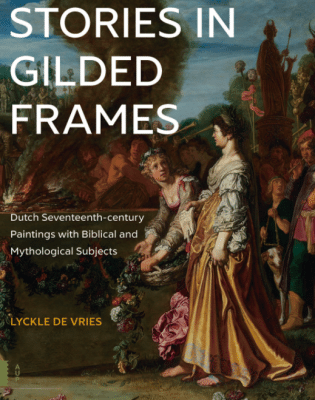Not surprisingly, the most respected genre of art, which appealed to the wealthiest and most educated buyers and fetched the highest prices for Dutch painters in the seventeenth century, was history painting. Selecting and interpreting incidents from biblical narratives or stories drawn from history and ancient mythology also called for educated artists who knew the written sources and were familiar with earlier representations of stories which could serve as models to emulate or challenge a painter’s quest to find dramatic arrangements of figures and effective handing of poses, gestures and facial expressions, while mustering appropriate brushwork, color and lighting. Modern scholarship has further revealed how often such paintings presented quandaries or situations that would resonate with the experience of living in the Dutch world of the seventeenth century.
The taste for Dutch history painting in our time by artists other than Rembrandt is a rather recent phenomenon. New attention to these less familiar artists was launched in large part by the Gods, Saints, and Heroes exhibition at the Rijksmuseum and the Detroit Institute of Arts in 1981, followed by accelerating and significant research, notably Eric Jan Sluijter’s recent Rembrandt Rivals: History Painting in Amsterdam 1630-1650) of 2015, and increasing exhibitions that focus on individual artists, including Goltzius (2003), Lastman (2006), Lievens (2008), Bloemaert (2011), Honthorst (2015), Schalcken (2015), Lairesse (2016) and Bol and Flinck (2017), among others.
To the usual, non-specialist museum visitor, none of these names would likely ring any bells, nor would titles such as Achilles among Lycomedes’ Daughters, Eliezer Offering Gifts to Rebekah or The Angel Leaving Tobias and his Parents. Lyckle de Vries’s mission in Stories in Gilded Frames is therefore a more challenging one than in his earlier Verhalen uit kamer, keuken en kroeg of 2005, written to make Dutch genre painting accessible to a wider audience. This volume bravely proposes to do the same for Netherlandish (mostly Dutch) history painting, covering the century as a whole in a chronologically ordered text of 163 pages, followed by 100 color illustrations, covering forty-one painters from Maerten de Vos to Nicolaes Berchem, with twenty-one additional, comparative black and white illustrations.
As every museum curator knows, today’s viewers and readers have short attention spans and tend to be impatient with difficult or unfamiliar language or subject matter. Two ways of engaging the reader in this book are its excellent color illustrations, easy to study since each occupies its own page, and presenting most of the textual information in relatively condensed, easily digested blocks, many of which are devoted to clearly titled discussions of each of the artists illustrated, interspersed with short, titled sections that consider related materials such as historical events of the period, the definition of varied styles of painting, artists’ training, how paintings were collected and displayed, artists’ use of settings and landscapes, the importance of scale in painting, the influence of the court or wealthy merchants on artists’ styles, patronage for art in the Netherlands, history paintings as propaganda or as installations in public buildings, popular narrative subjects, and relationships between history painting and genre painting.
Lyckle de Vries’s deep knowledge of this material, his accessible way of writing and his engaging and generous enthusiasm in wanting to share history painting with new readers, is evident throughout this volume. Yet this reader – projecting herself into the audience for whom the book was intended – finds certain potential problems in the layout of the volume itself which could pose barriers for these readers, primarily in the complete separation of text from illustrations. Difficulties in navigating easily back and forth between the two might have been mitigated by citing, on each illustration, the page numbers to link it with discussions of the painting itself and other interpretation of the same subject. An unfortunate binding error, beginning with the first color plate, occurs at intervals throughout the color illustrations, putting many out of order.
The way for a general, non-specialist reader to use this volume most effectively, I believe, would be to read the preface and introduction first and then follow in the footsteps of the author himself, who mentions that he chose the illustrations before writing the body of the text because he wanted to shape his discussion around what he considered to be the most useful and important examples of history painting that would best illustrate the variety and development of this subject genre throughout the century. The curious reader might therefore begin by exploring these 100 excellent color plates just as one might examine and respond to paintings in a museum. Having closely considered images that draw attention first, he or she would then feel equipped to read the author’s interpretation and analysis, within the section devoted to each individual artist, and then move on to more and more related information about the period and the subject type. Understanding the overall chronology would become much easier once a reader has learned how to look at the paintings.
Although this book was not written for a scholarly audience, seeking extensive footnoting and a full reference bibliography, considerations of individual paintings offer rewards throughout the volume, as the author, avoiding arcane art historical terminology, pays close attention to how each narrative interprets its text through careful staging of a story, including the placement and interpretation of secondary figures and manipulations of light, color and space. De Vries’s thoughtful discussion of Rembrandt’s Denial of Saint Peter of 1660 in conjunction with Honthorst’s treatment of the same theme (pp. 129-130) is one of many such comparisons that demonstrate how observation of different artists’ treatments of the same subject can deepen a reader’s understanding of the narratives themselves while clarifying how artists creatively formulate their interpretations of stories. Studying the pictures and reading their parallel texts, a reader can begin to see why certain decisions were made, and can then use de Vries’s models of visual thinking for future encounters with history paintings in museum settings.
Susan Donahue Kuretsky
Vassar College
